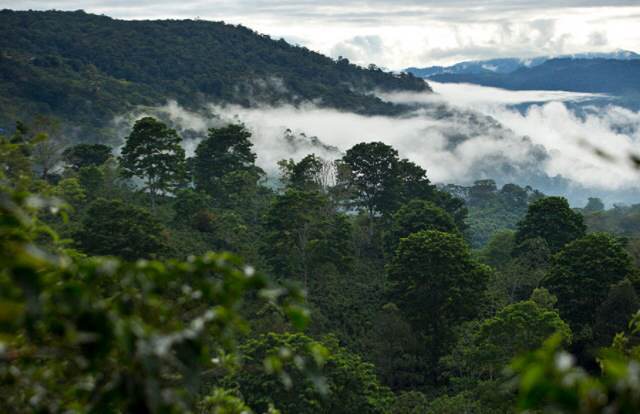Without Economic Incentives, Protecting Global Forests May Prove Impossible (Op-Ed)


Kate Dillon Levin is with the Corporate Engagement Team at Code REDD and Jeff Hayward is director of the Climate Program at Rainforest Alliance. This article is adapted from an article for the Skoll World Forum. The authors contributed this article to LiveScience's Expert Voices: Op-Ed & Insights.
The lowland Mayan forests of northern Guatemala teem with wildlife — toucans, macaws, howler monkeys, and even the fabled jaguar. This is a forest reborn, as nearly 2,000 years ago it was completely deforested by the ancient Mayan civilization. Nature and time have allowed a second chance for the forest to heal.
But today, the Mayan forest is once again threatened — this time by economic activities such as cattle ranching and agriculture. If destroyed again, it is not likely to come back.
There is hope, however, in forests designated for community use. In these areas, the deforestation rate is 20 times slower than in areas not under the care of local people. These communities practice sustainable harvesting and generate millions of dollars of revenue annually through the sale of certified timber and xate (an ornamental palm frond), benefiting close to 5,000 local people.
The threat of deforestation looms
Such communities in Guatemala deserve credit for pursuing sustainable forestry when the economic incentives for unsustainable land use around them remain strong. Although forests should be more valuable than at any time in human history, today they are worth more when cleared for cattle, oil palm, soy or pulp production. And this pressure is only increasing with population growth and global demand for agricultural commodities.
But a new paradigm of growth is emerging through a mechanism known as Reducing Emissions from Deforestation and Forest Degradation (REDD+). By valuing the carbon stored in forests, REDD+ is changing the economic incentives around land use in developing forest countries. Sales of verified REDD+ carbon credits effectively give these countries and communities the credit they deserve for choosing a sustainable pathway to development.
Get the world’s most fascinating discoveries delivered straight to your inbox.
Envisioned as an integrated climate and development solution, hopes were high that global carbon markets would yield sustainable financing for REDD+ conservation and sustainable forest management. Progress on an international agreement edges forward, however, and regulated markets have been slow to materialize. As a result, today REDD+ is at a crossroads as the potential supply of REDD+ credits on the voluntary carbon market significantly outpaces demand.
Yet, it is important to note that REDD+ is working for the planet and for businesses. Today, REDD+ projects protect 14 million hectares of threatened forests across the globe (an area the size of Bangladesh) and reduce emissions by 22 million tonnes (metric tons) of CO2 annually. The world's leading companies recognize that investing in efforts to stop deforestation in exchange for verified emissions reductions is a compelling way to optimize their corporate impact. Microsoft, Kering, Natura, Disney, and Barclays are among those taking voluntary action — addressing the greenhouse gas emissions they cannot avoid by purchasing REDD+ credits.
REDD+ financing for sustainable supply
REDD+ is working, but it needs more support in order to achieve a meaningful impact. The world continues to lose its forests at an alarming rate — approximately an area the size of Manhattan every day. Tropical forests are vital to human health and well-being; they determine the quality, quantity and regularity of global water supplies, gobble up carbon dioxide, house vital biodiversity hotspots and provide shelter for half a billion people. And not least, they are a source of inspiration and beauty.
Multinational corporations sourcing commodities play a significant role in driving forest loss, so they will be pivotal to the solution. Global business must take on a new, coordinated imperative to lessen its forest footprint. Corporations large and small are making significant, public pledges to reduce deforestation in supply chains. Companies within the Consumer Goods Forum, whose total annual sales exceed $3 trillion, have pledged to remove deforestation from their supply chains by 2020.
These kinds of commitments are important, but may not go far enough to meet the scale of need and can be reinforced by REDD+ financing. While a solid framework for sustainable land use is essential for long-term conservation, payments for long-term conservation via REDD+ is essential for supporting sustainable land management. Back in the lowland Mayan forests of Guatemala, the communities defending their forests against strong economic pressures plan to use income from REDD+ to strengthen the viability of their sustainable forest enterprises.
Given recent revelations by the Intergovernmental Panel on Climate Change and the U.N. Environment Program Emissions Gap Report — which warn that current actions to cut emissions are insufficient and unlikely to prevent catastrophic climate change — society must use every available effort to curb emissions. Deforestation, as part of the problem, must also be part of the solution, and that solution will require a change in economic incentives. We believe forest conservation — and thus sustainable supply management — will require REDD+.
This article originally appeared as "Giving credit where credit is due: Using REDD+ finance to enhance Sustainable Forest Management" on the Skoll World Forum on Social Entrepreneurship, a premier international platform for accelerating entrepreneurial approaches and innovative solutions to the world's most pressing social issues. The views expressed are those of the author and do not necessarily reflect the views of the publisher. This version of the article was originally published on LiveScience.



